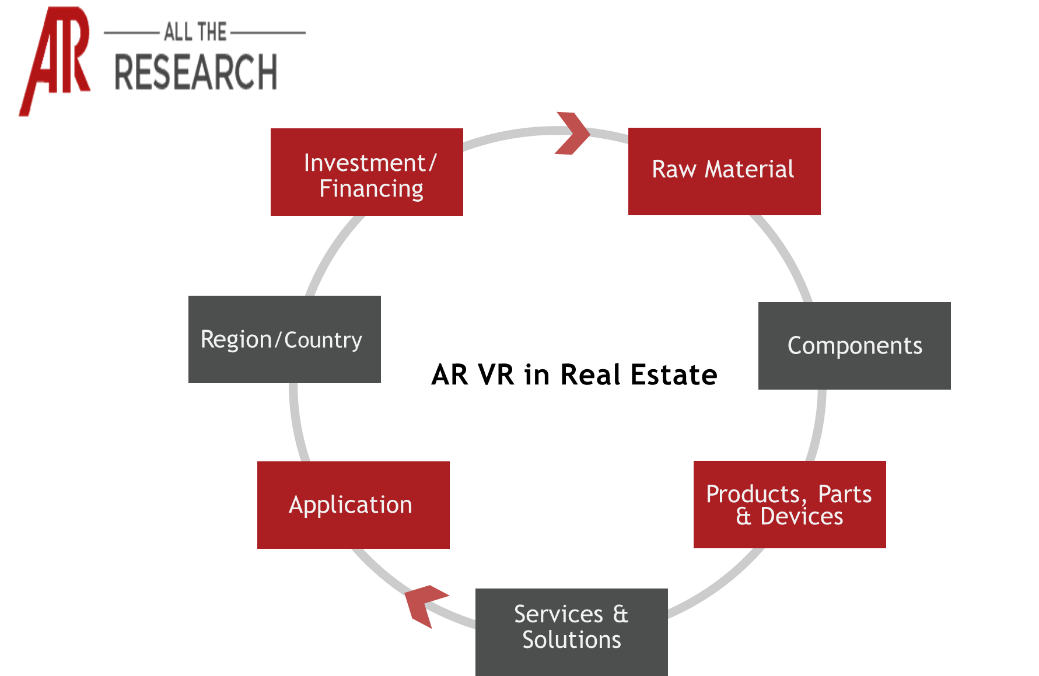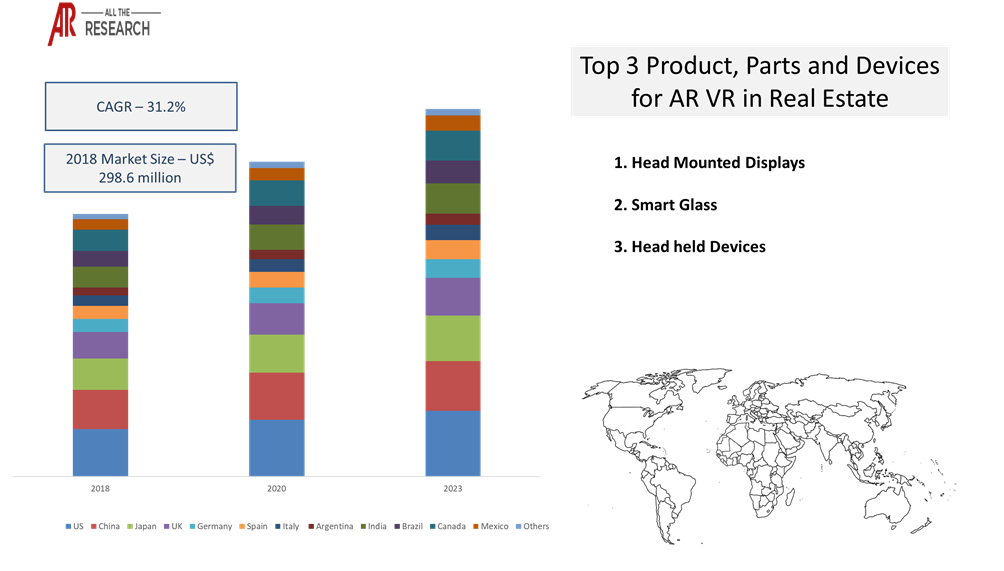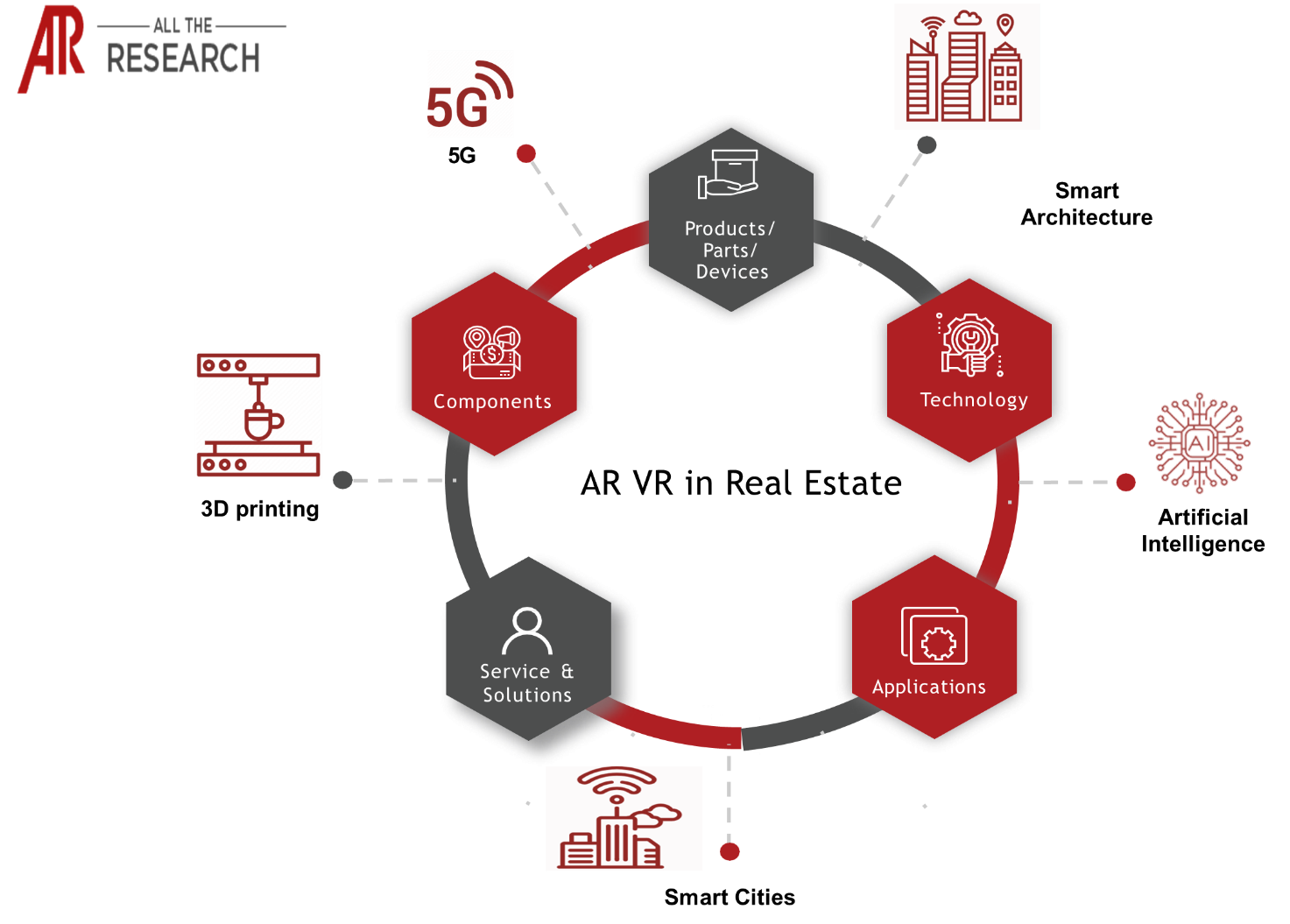Augmented Reality (AR) & Virtual Reality (VR) in Real Estate Market Ecosystem has the potential to change the overall property market, especially with the recent developments made in terms of developing consumer-level technology. The new range of affordable and accessible hardware and software means that the property marketplace will offer an enhanced consumer experience for every touchpoint in the real estate experience, from architects, planners, builders, and clients to real estate agents, who have invested in the process.
AR VR in real estate is a powerful tool that creates compelling experiences for buyers, and it allows real estate professionals to showcase properties and homes digitally from anywhere across the globe. With the help of VR, a developer or a prospective buyer can access a lifelike simulation of any property. VR holds immense potential for real estate and architecture, with artificially conjured 3D environments taking out the hassle of visiting properties or eliminating the limitation of inspecting online testing.
The AR technology overlays the 3D digital image on top of the physical world with the help of smart glasses, mobile phones, helmets, and visors, in order to create a mixed reality enhanced with 3D animated visuals. This helps in the visualization of the property in 3D while also allowing for the creation of an intricate and fully realized vision of the said property.
In 2019, 90% of households have begun real estate search on the internet, with 50% of the searches being made from mobile devices. In order to enhance user experience on the realtor’s website, a virtual presence of the property highlights Points of Interest (POIs) that gives the potential purchasers a clear understanding of the property. However, underproductive physical visits despite appealing POIs can result in added cost of sale if buyers are unable to correlate the imagined property to the actual one.
Both AR VR are currently used in the real estate industry to help builders, architects, sellers, and buyers to cut costs and increase productivity. These applications have become popular over the years, as technology has become affordable and better.
Get a Sample Copy of the report at https://www.alltheresearch.com/sample-request/380

|
Raw Material |
Components |
Products, Parts and Devices |
Services & Solutions |
Application |
|
Silicon |
Sensors |
Head Up Displays |
Documentation |
Training |
|
GaN |
Camera |
Head Mounted Displays |
Visualization |
Monitoring/ Maintenance |
|
Glass |
IMU |
Smart Glass |
3D Modelling |
|
|
SiC |
Processor |
Handheld Devices |
Navigation |
|
|
Metals |
Modules |
|
Workflow Optimization |
|
|
Others |
Graphics (Cards) |
|
Others |
|
|
|
Audio (ICs) |
|
|
|
|
|
Memory |
|
|
|
|
|
Display |
|
|
|
|
|
Others |
|
|
|
In terms of products, parts and services, the market has been segmented into Head Up Displays, Head Mounted Displays, Smart Glass, and Handheld Devices. Head-Mounted Displays dominated the market in 2018 and is expected to a display a similar trend in the coming years. The construction industry has been growing at a moderate rate over the years and the growth rate is expected to reach 30% during the forecast period. China, the U.S, and India are leading the way and accounted for more than 50% of the global growth in 2018. Therefore, this has resulted in a rise in demand for AR VR in the real estate industry over the years
The global AR VR in Real Estate Market Ecosystem was valued at US$ 298.6 Mn in 2018 and is expected to reach US$ 1,151.9 Mn in 2023, expanding at a CAGR of 31.2% during the forecast period. Major companies operating in the market are Google, Microsoft, Facebook, MyPad3D, Matterport, Mirage Reality., Juego Studio Private Limited, ALLERIN, Scapic, VirtualAPT, RealVision, Rooomy, Truss, Strayos, IrisVR, Realar, Autodesk, Floored Build, VR Global, Inc., 3M, and Fologram Pty Ltd., among others
North America dominated the market in 2018 and is expected to display a similar trend in the coming years. The US is leading the market in terms of AR VR adoption in the real estate sector. The Asia Pacific region is expected to witness the fastest growth during the forecast period. China and India are leading the way in the Asia Pacific region, owing to the rapid growth of the construction sector.

There are many trends that are having an impact on the market forecast. These, when evaluated from a company’s perspective, can drive growth. Our numerous consulting projects have generated sizeable synergies across all regions and all sizes of companies.
|
Company |
Ecosystem Positioning |
Total Revenue (2018) |
Industry |
Region |
|
|
Products, Parts and Devices |
US$ 136.81 bn |
AR VR |
Global |
|
|
Products, Parts and Devices |
US$ 55.83 bn |
AR VR |
Global |
|
Microsoft Corporation |
Products, Parts and Devices |
US$ 110.36 bn |
AR VR |
Global |
|
HTC Corporation |
Products, Parts and Devices |
US$ 0.73 bn |
AR VR |
Global |
Very few markets have interconnectivity with other markets like AR VR. Our Interconnectivity module focuses on the key nodes of heterogeneous markets in detail. Artificial Intelligence, Industrial Internet of Things, Autonomous Vehicles, 5G technology, and 3D printing markets are some of our key researched markets.

|
Trends |
Impact |
|
Virtual reality and augmented reality are changing the scenario of the real estate business. This technology is used to give buyer a virtual view of construction sites by using tablets, smartphones, and AR VR devices. |
0.16% |
|
Virtual reality is used by architectures to provide a realistic view of the design to real estate developers, thereby helping designers and architects to gain the trust of clients with their designs. |
0.08% |

Ask for free product review call with the author

Share your specific research requirements for a customized report

Request for due diligence and consumer centric studies

Request for study updates, segment specific and country level reports
